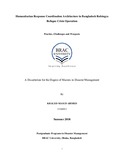| dc.contributor.advisor | Kabir, Md. Humayun | |
| dc.contributor.author | Ahmed, Khaled Masud | |
| dc.date.accessioned | 2019-03-10T07:06:03Z | |
| dc.date.available | 2019-03-10T07:06:03Z | |
| dc.date.copyright | 2018 | |
| dc.date.issued | 2018 | |
| dc.identifier.other | ID 13168011 | |
| dc.identifier.uri | http://hdl.handle.net/10361/11537 | |
| dc.description | This dissertation is submitted in partial fulfillment of the requirements for the degree of Master in Disaster Management, 2018. | en_US |
| dc.description | Cataloged from PDF version of dissertation. | |
| dc.description | Includes bibliographical references (page 48-50). | |
| dc.description.abstract | Bangladesh is hosting over a million of forcibly displaced population who fled violence and ethnic cleansing in Myanmar. The new influx of around 400,000 people took shelter in peninsula of Teknaf and Ukhia of Cox`s Bazar. These arrivals have caused humanitarian crisis which is categorized as a one of global growing ``refugee`` crisis. The massive scale of refugee populations has led to life saving needs. Although Rohingya crisis has received huge global attention, efforts to continue to mobilize and sustain resources to cater to basic needs have people. In a changing humanitarian landscape, government with it humanitarian partners including UN, Red Cross and NGOs are striving for response coordination architecture to operate in complex humanitarian setting.
Evidence shows that parallel coordination structures do not benefit agencies to work in coordinated fashion rather they operate in isolation. Thus, overall coordination architecture is yet to form to guide an interoperable and coordinated response strategy. On the same note, working with own mandates, organizations, including government become unable to deliver integrated assistance and therefore it does not gain expected impact. This paper represents the issues of Rohingya crisis and the existing response coordination situation, problems, process and findings through literature review, key informant interviews (KII) of people directly involved in the complex operation and focus group discussions. The objectives of the study to analyze the coordination structure of humanitarian organizations in Bangladesh, in case of Rohingya crisis and compare with international standard. This paper will also find out the challenges and advantages of Cluster approach. | en_US |
| dc.description.statementofresponsibility | Khaled Masud Ahmed | |
| dc.format.extent | 50 pages | |
| dc.language.iso | en | en_US |
| dc.publisher | BRAC University | en_US |
| dc.rights | BRAC University dissertations are protected by copyright. They may be viewed from this source for any purpose, but reproduction or distribution in any format is prohibited without written permission. | |
| dc.subject | Rohingya | en_US |
| dc.subject | Refugee crisis | en_US |
| dc.subject | Ethnic cleansing | en_US |
| dc.subject | Cluster approach | en_US |
| dc.subject.lcsh | Refugees -- Burma. | |
| dc.title | Humanitarian response coordination architecture in Bangladesh Rohingya refugee crisis operation: practice, challenges and prospects | en_US |
| dc.type | Dissertation | en_US |
| dc.contributor.department | Department of Architecture, BRAC University | |
| dc.description.degree | M. Disaster Management | |

